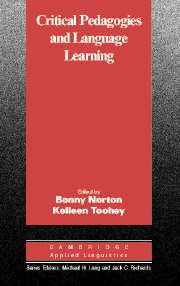Book contents
- Frontmatter
- Contents
- List of contributors
- Acknowledgments
- Chapter 1 Critical pedagogies and language learning: An introduction
- I RECONCEPTUALIZING SECOND LANGUAGE EDUCATION
- II CHALLENGING IDENTITIES
- III RESEARCHING CRITICAL PRACTICES
- IV EDUCATING TEACHERS FOR CHANGE
- Chapter 14 Introducing a critical pedagogical curriculum: A feminist reflexive account
- Chapter 15 Negotiating expertise in an action research community
- Chapter 16 Performed ethnography for critical language teacher education
- Chapter 17 Critical moments in a TESOL praxicum
- Author Index
- Subject Index
Chapter 17 - Critical moments in a TESOL praxicum
Published online by Cambridge University Press: 05 October 2012
- Frontmatter
- Contents
- List of contributors
- Acknowledgments
- Chapter 1 Critical pedagogies and language learning: An introduction
- I RECONCEPTUALIZING SECOND LANGUAGE EDUCATION
- II CHALLENGING IDENTITIES
- III RESEARCHING CRITICAL PRACTICES
- IV EDUCATING TEACHERS FOR CHANGE
- Chapter 14 Introducing a critical pedagogical curriculum: A feminist reflexive account
- Chapter 15 Negotiating expertise in an action research community
- Chapter 16 Performed ethnography for critical language teacher education
- Chapter 17 Critical moments in a TESOL praxicum
- Author Index
- Subject Index
Summary
Departures
The two-level suburban train clanks out of Central Station. Heading away from the city, it's not as crowded as the incoming trains, but I still find myself having to stand by the doors. We creak and rattle across several sets of points before finding our suburban heading, passing through increasingly unfamiliar station names. Outside, it's an achingly clear blue morning; the air is chilly, but the sun is starting to warm the day. It's June, which means the start of winter and the end of the semester just round the corner. Essay marking and clear blue skies. And that end-of-semester exhaustion. It's been another long semester: conferences in Manila, Vancouver, Singapore, Abu Dhabi; I was teaching from 7 to 9 last night; and here I amon a Friday morning, heading off to find a small language school somewhere in the suburbs whose address I fortunately remembered to print off from my e-mail late last night.
The TESOL (teaching English to speakers of other languages) practicum. For many of us involved in teacher education, the teaching practicum holds, I think, a certain ambivalence: It's hard work; it's disruptive; it involves lots of traveling; it's too time consuming; it demands that we show expertise in a domain from which we are often increasingly distanced in our current work.
- Type
- Chapter
- Information
- Critical Pedagogies and Language Learning , pp. 327 - 346Publisher: Cambridge University PressPrint publication year: 2004
- 54
- Cited by



